Talent acquisition and recruitment are often used synonymously with one another. The truth is the latter approach is just one of many facets of the former approach.
Look at companies that successfully transitioned from an early-stage startup to a large-scale enterprise. Their sustainable, predictable headcount growth was not by accident.
These organizations made a substantial, long-term investment in their talent acquisition functions to ensure they had the necessary in-house people, processes and technology to fill critical roles across their businesses with high-quality candidates quickly and efficiently.
Because of this investment, these companies’ talent teams have transformed into strategic pillars that helped (and continue to help) scale their businesses.
Moreover, their talent acquisition leaders now have a (rightful) seat at the C-suite table where their voice is heard regarding important business decisions.
“Executives at companies across industries and of all sizes now realize the outsized impact a well-constructed talent acquisition function can have on their company culture, employee productivity and bottom line,” said Lever Director of Product Marketing Chris Winkler.
You already know a fair amount about talent acquisition. However, this guide offers in-depth information and insights that can help you and your TA team:
- Understand what the ideal talent acquisition org structure looks like
- Learn what the best TA strategies entail (with real-world examples)
- Find out what tech you need to succeed daily and in the long term
- Discover what it takes to become a “transformational” talent team
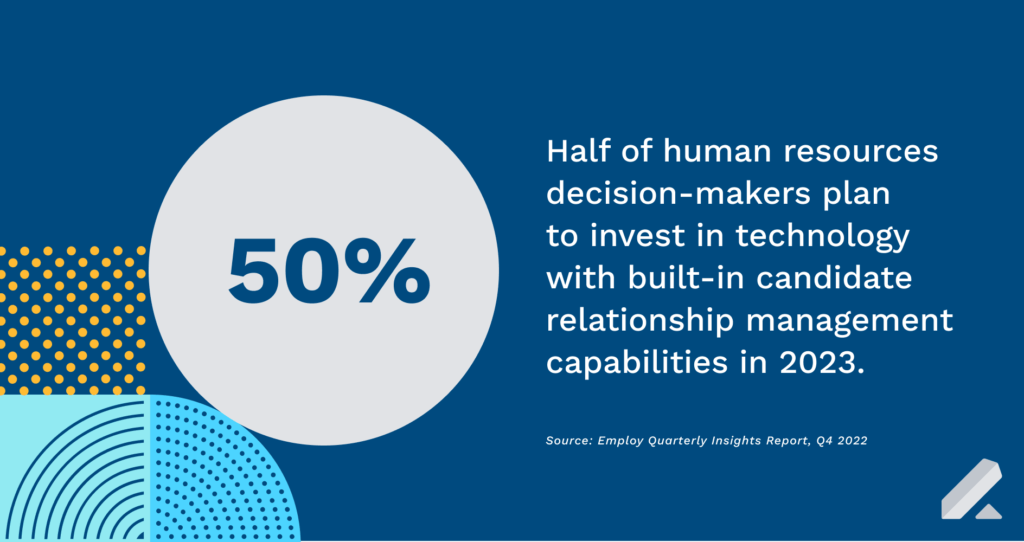
What is talent acquisition?
The most common talent acquisition definition is:
The planning, execution and ongoing optimization of internal and external recruiting activities that lead to the hiring and retention of high-performing employees.
A more nuanced definition of talent acquisition is:
The attraction, engagement and conversion of qualified professionals — ones will fill important organizational needs and contribute to business growth — through a data-backed candidate relationship management (CRM) strategy.
The most crucial daily tasks talent teams tackle — especially tasks that encompass the modern talent relationship management (TRM) lifecycle — include:
Sourcing: Adding many qualified candidates to one’s talent acquisition solution daily
Relying solely on applicants to fill job openings isn’t viable for today’s TA teams.
Talent specialists must also proactively engage potential candidates whose experience, qualifications and skills align with job requirements (i.e., criteria from hiring managers).
There is no one-size-fits-all sourcing approach. Instead, recruiters must try multiple sourcing avenues and marketing techniques to engage and convert prospects.
Nurturing: Engaging passive prospects with personalized, timely messages
It’s critical to fill the talent pool with many qualified candidates. But recruiters must use personalized nurture campaigns to keep the candidates engaged.
Leveraging channels like text and email and regularly testing the schedule, cadence and copy of those messages improve nurture campaign performance.
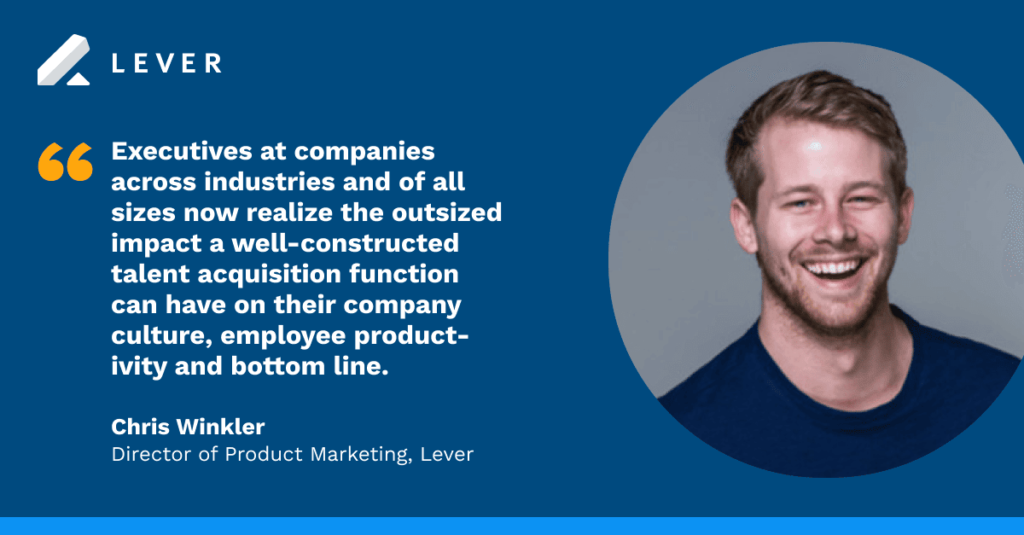
Interviewing: Talking to candidates of interest with other hiring team members
This stage aims to help the hiring manager and the interview panel learn about and compare the candidates and convert the most suitable one.
As with sourcing, no two companies’ structured interview cycles are the same. But building a framework that leads to efficient, unbiased interviews is critical.
Hiring: Extending offers to and employing the best job candidates
Hiring teams who chat with multiple candidates for a given role must then provide their feedback on the prospects in question (and in silos, until all feedback is compiled, to avoid any bias in decision-making).
Once this feedback is completed, hiring stakeholders can discuss their perceived pros and cons for candidates and recommend who to extend an offer to. Ultimately, the hiring manager decides who they think is the ideal candidate to join their team.
Analyzing: Reviewing data associated with the entire recruitment process
There are many moving parts to get candidates from the start of the recruitment funnel to the “finish line.” Talent teams must analyze insights tied to their work to improve with each successive recruiting and hiring cycle.
This data deep-dive shows them what worked with their recruiting (e.g., candidates express positive sentiment about the interview process) and what didn’t (e.g., certain interview stages were too long and led to a high candidate “drop-off” rate).
Rediscovering: Resurfacing previously engaged talent in one’s database
Legacy recruitment databases prevent recruiters from reengaging previously engaged prospects. This is because these solutions lack functionality that resurface top talent.
Some TA suites offer candidate rediscovery capabilities (i.e., recommendations and search features) that help talent specialists reexamine “known” leads.

What modern talent acquisition teams look like
You now know what talent acquisition entails and the core tasks TA leaders and specialists conduct on their own and with the aid of hiring team members.
Now, let’s look at the typical makeup of a modern talent acquisition team and each individual’s role in the recruiting and hiring process.
Chief human resources officer
Not every organization combines human resources and talent acquisition. Some companies prefer to keep the two business units separate. In these instances:
- Human resources focuses on employee onboarding, upskilling, engagement and retention; owns their company’s internal mobility program; and works with their diversity, equity and inclusion (DEI) committee on various initiatives (e.g., developing employee resources groups)
- Talent acquisition focuses on identifying, engaging and converting potential candidates and analyzing historical and recent recruiting performance data to identify individual and collective strengths and areas for improvement (e.g., ways to improve speed and efficiency)
However, many businesses still fold talent acquisition into their HR department.
In this setup, the Chief Human Resources Officer (CHRO) oversees TA and relays requests from the leadership team and hiring managers (e.g., new hiring priorities for certain teams or roles) to talent leaders. These TA directors then help recruiters adjust their sourcing and nurturing efforts as needed.
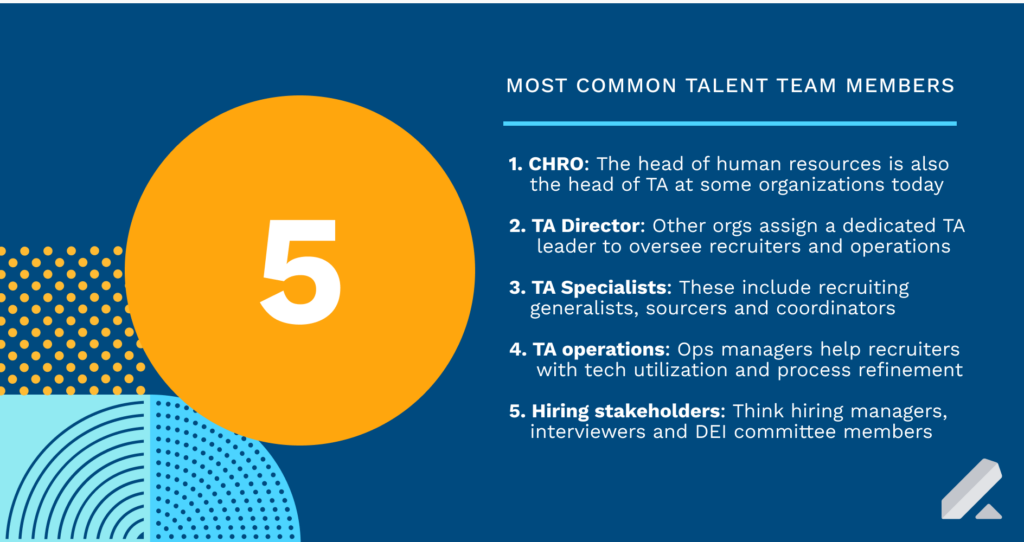
Director of talent acquisition
Speaking of talent acquisition directors, these individuals own and operate their org’s TA strategies outright when their teams aren’t incorporated in their HR department.
The average talent leader:
- Liaises with C-level leaders and partners on workforce planning — not just to “take orders” from their leadership team to execute (i.e., specific requisitions to prioritize next), but also to provide data-driven insights to help inform hiring plans
- Aligns their TA functions with the goals and strategic needs of the business
- Leverages a holistic view of their team’s performance and related business objectives using robust talent analytics that “blends” with HR’s data set
- Standardizes their talent acquisition teams’ processes and ensuring they have the well-built TA technology stacks that support those processes
“Setting their recruiters up for success day in and day out helps talent leaders get the most out of their TA staff,” said Roy. “These efforts have a trickle-down effect.
“Recruiters who have clear guidance from and regular check-ins with their talent directors are able to continually enhance their efforts to engage and convert active opportunities and make strides with DEI and candidate experience to boot,” Roy added.
Talent acquisition specialists
The heart and soul of every company’s talent team are the “on-the-ground” personnel who execute the plans crafted by CHROs and/or TA leaders.
That said, there are different “flavors” of talent acquisition specialists you will commonly find at companies today, including (but not limited to):
- Generalist: This TA team member wears several hats (e.g., writing impact job descriptions, advertising roles on job boards and social media, “matching” archived candidates to new and future openings).
- Sourcer: Sourcers scour LinkedIn, Indeed, Wellfound and other popular (and even niche) career communities to identify qualified, diverse candidates to contact and gauge their interest in available positions.
- Coordinator: Dedicated talent coordinators to keep recruiters on track. Pipeline management is often a core responsibility of coordinators, as this helps recruiters stay organized and on schedule.
- CX specialist: Many TA teams employ candidate experience specialists to advise recruiters on how to provide a consistently top-tier CX and reduce dissatisfaction among hired and archived prospects.
“Not every talent acquisition team will have all these roles,” said Chris.
“But many scaling TA leaders now understand that assigning recruiters to niche positions like these can help ensure they leave no stone unturned when it comes to enhancing their individual and collective output,” Chris added.
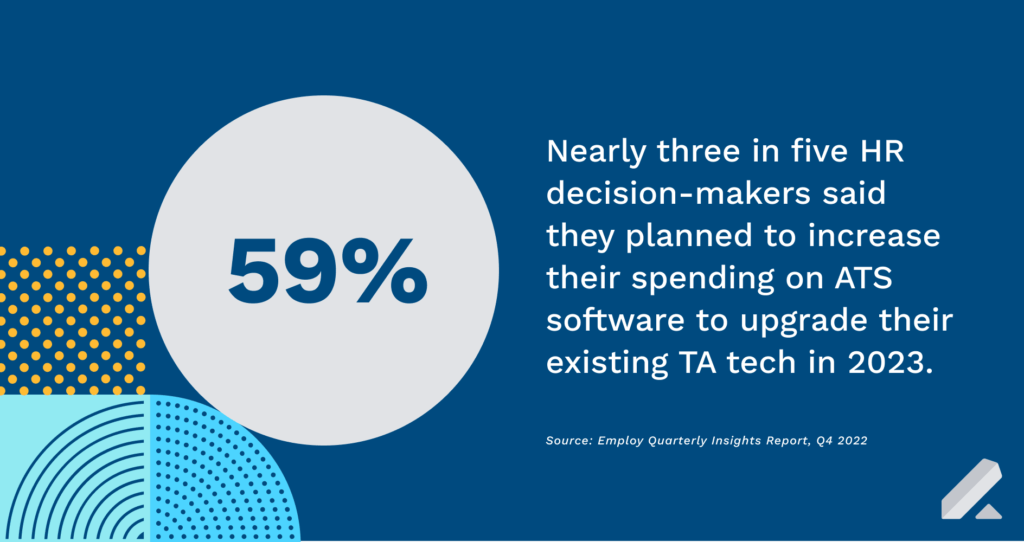
Recruiting operations managers
If recruiters are the heart and soul of talent acquisition, operations is the backbone. These analytically minded TA professionals focus on two main tasks:
- 1) Technology utilization: Many teams across your average org are not tech-savvy. That means these departments need guidance to best utilize their solutions. Ops managers aid talent acquisition with onboarding new platforms and relaying best practices from those software providers to recruiters to ensure they can take full advantage of the tech.
- 2) Process refinement: Operations managers also eliminate dated and inefficient processes and create new, better processes in their place. These professionals are especially concerned with processes around the primary TA solution recruiters use to source and nurture candidates and manage and analyze their pipelines.
“Operations managers don’t just keep the talent acquisition ship afloat,” said Roy.
“They also ensure recruiters can thrive using the tools they have at their disposal and unearth actionable insights talent leaders and specialists alike can exploit to augment their work and improve key metrics,” Roy added.
Other key hiring stakeholders
There are other hiring team members who play pivotal roles in the recruiting process:
- Hiring managers who submit requisitions to fill new/open roles on their teams
- Interview panelists who speak with candidates and offer their feedback/scores
- The CEO and CRO/CFO who dictate the overall growth direction of the business
- DEI committee members who ensure diverse candidates are sourced/engaged
- HR generalists who “complete” a candidate’s experience through onboarding
Each stakeholder has a unique perspective, as it pertains to the recruitment and hiring process. Collectively, these unique vantage points lead to more intelligent hiring decisions — and a more productive talent acquisition team.

How today’s leading talent acquisition teams operate
Leading TA orgs work closely with executives, human resources, people managers, operations, and other key stakeholders to continually improve in key areas that cumulatively impact their ability to hire and retain top talent.
Workforce planning to map out headcount needs
The C-suite decides which business unit to prioritize in terms of headcount in their quarterly and annual workforce planning sessions (in part based on insights and suggestions provided by talent leaders). It’s then on TA directors to follow these requests and prepare their recruiters accordingly.
Talent leaders must also meet with HR when headcount needs and priorities change (e.g., when the business needs new engineers to support software expansion).
Candidate sourcing to augment recruiters’ outreach
The top talent teams gradually refine their sourcing by using data to determine which specific sources work best and worst for finding qualified candidates.
But hiring managers also often know where to find premier prospects based on their past hiring experiences. Talent specialists can glean these insights during kickoff calls after requisitions are approved.
Recruitment marketing to boost conversion rates
Hiring managers often suggest language and value propositions to include in candidate nurture campaigns (i.e., series of personalized text messages and/or emails to prospects of interest) and job listing and career page copy.
Talent specialists must craft messaging for this collateral. But hiring managers’ voices must also be factored in to ensure the role-related assets support their needs.
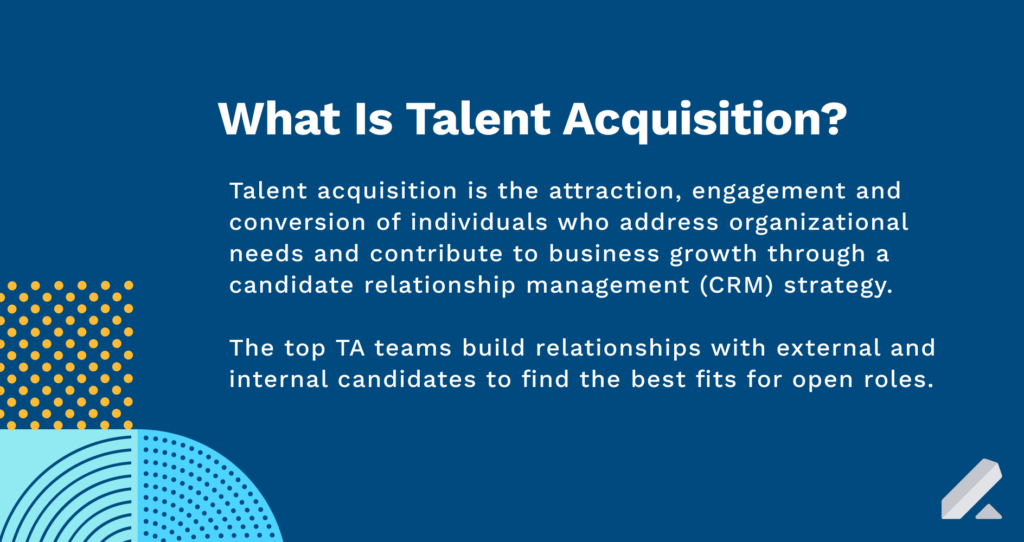
Employer branding to best promote the business
Human resources also helps with recruitment marketing — specifically with how the employer brand is positioned within promotional content posted on the company website and used in external messaging.
The HR team also handles brand reputation management and employee referral generation to aid TA. Both activities impact application totals and nurture engagement.
Compliance to abide by data regulation measures
Operations managers must be able to handle real-time requests for candidate data deletion — something your C-suite wants them to prioritize to avoid non-compliance and penalties. That means they need a user seat for TA’s primary candidate database.
Internal mobility to advance and retain employees
The Great Resignation caused countless professionals to quit their jobs. Many people put in their notice due to the effects of the global pandemic and job burnout. But some also did so due to a lack of career mobility options.
This is why TA and HR now often work together on internal mobility: to allow employees to express interest in open and future roles and help talent teams learn which current workforce members would be good fits for those positions.
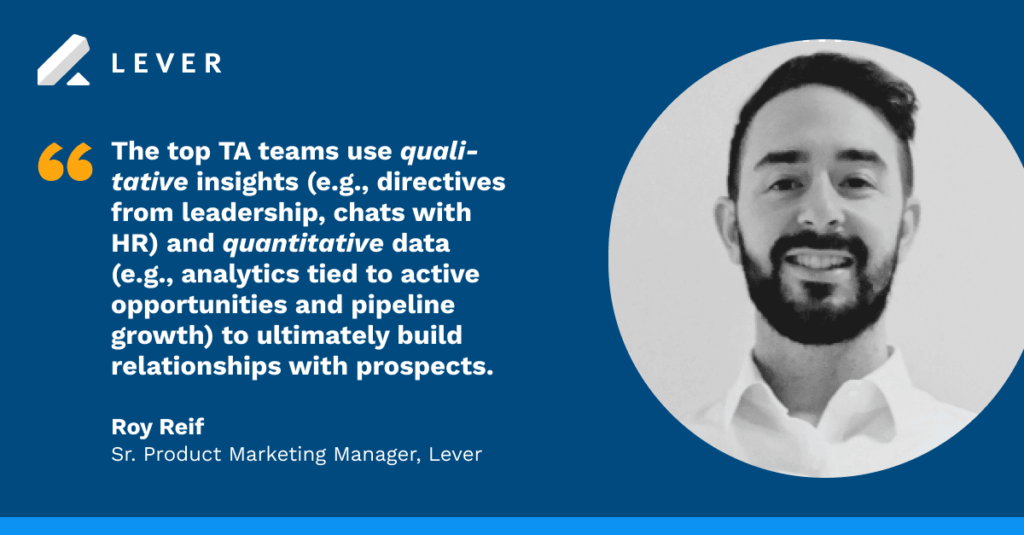
Diversity recruiting to aid TA with DEI hiring efforts
Improving diversity, equity and inclusion is a table-stakes initiative for every company. However, achieving DEI goals is a collective effort by everyone at a business.
Employees can aid their orgs’ DEI efforts through referrals. Recruiters want to add candidates from various backgrounds to their talent pools, and internal referrals help.
Recruitment outsourcing to ease the burden for TA
Some TA teams have lofty hiring goals assigned by leadership — goals they can’t meet without the aid of external talent acquisition consultants or agencies. Many scaling orgs and Fortune 500 firms lean on outside partners often.
For instance, some enterprises use recruitment process outsourcing (RPO) agencies to outsource a talent search (e.g., C-level or technical roles). RPOs are used when in-house TA specialists don’t have the expertise or bandwidth to launch a search.
Analysis and reporting to unearth valuable insights
Truly data-driven talent acquisition teams sync their recruitment tech with the HCM and/or HRIS used by HR. The “blended” candidate and employee data helps them get quality-of-hire insights that can help elevate their recruiting.
Merging TA-owned recruiting data with HR’s post-hire data enables talent teams to better discern what traits high-quality hires have compared to the rest. These insights can then primarily inform changes to sourcing.

Talent acquisition metrics every TA team must track
“When you know better, you do better,” said Lever Group Product Manager Bec Powell.
“Clear and holistic measurement, forecasting, and predictive analytics throughout all stages of the hiring process empowers talent leaders to pinpoint exactly where to spend their energy to improve and adjust to an ever-evolving talent ecosystem,” Bec added.
With that in mind, here are several talent acquisition metrics recruiters must regularly improve to appease their talent leaders and other key hiring stakeholders.
Speed: How quickly recruiters advance candidates through the funnel and fill key roles
- Time to hire: The average number of days from when a recruiter is assigned a new requisition to when an active candidate formally accepts a job offer
- Time to fill: The average number of days from when a requisition is approved by leadership to the first day the candidate who accepted an offer starts their job
- Time to feedback: The average amount of time it takes (hours, days or weeks) for every interview panelist to provide feedback for a given candidate they spoke with
- Days in stage: The average number of days a lead spends in a recruitment funnel stage (can be used to calculate time in stage for specific roles, teams and locations)
- Pipeline speed: The amount of time (days, weeks or months) it takes a talent team and specific recruiters to meet their talent pipeline’s target quota
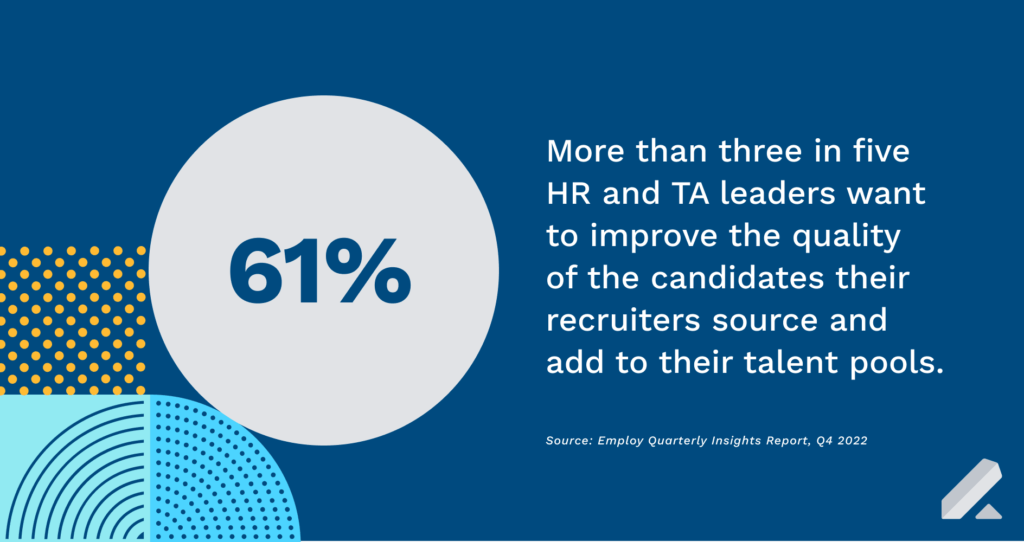
Efficiency: Productivity and cost-effectiveness of individual recruiters and the entire TA team
- Cost per hire: The average amount of money spent to make and onboard a net-new hire (accounting solely for external candidate who accept an offer)
- Offer acceptance rate: The average rate of job offers extended to candidates that are accepted over a given period, including by team, location and diversity
- Archived opportunities: The number and percentage of candidates who enter the recruitment cycle for a role but were eventually archived by talent teams
- Resumes/applications reviewed: The number, percentage and rate of submitted resumes and applications that are reviewed by recruiters over a given period
- Nurture engagement: The average open, click-through and reply rates of nurture emails and/or text messages sent by recruiters to passive prospects in their pipeline
Quality: Strength of sourced candidates, hiring stakeholder sentiment and employee output
- Quality of hire: Value an employee adds to a business based on predefined criteria set by HR and hiring managers (i.e., what they deem a low- or high-quality hire)
- Quality of source: Rating for sources based on predefined criteria set by talent teams (i.e., how frequently a source leads to engaged candidates and new hires)
- Sourcing diversity: The diversity makeup of one’s talent pool based on responses to EEO/DEI surveys included in job listings (latter survey often made optional)
- Candidate Net Promoter Score: Rating from engaged candidates that denotes the quality of CX provided (i.e., on a 1-10 scale, with 10 being the most satisfied)
- Hiring manager satisfaction: Rating scale (custom to each org) that denotes how satisfied hiring managers are with TA’s recruiting efforts for their open roles

The two types of talent acquisition technology
Putting the right people and processes in place is vital to the success of any talent acquisition strategy. However, an advanced ATS + CRM solution is equally essential to your TA team’s daily and long-term prosperity.
Standalone applicant tracking systems have been talent teams’ go-to tech for years. But many of these teams now realize they need complete talent acquisition suites to evolve their recruiting and hiring strategies, enhance their productivity and better contribute to business growth.
Here is how the two types of tech stack up against one another in five key areas.
1) Profiles and pipeline management
Marketing, sales and customer success teams depend on dynamic updates to prospects’ and customers’ profiles in their CRM software. Talent acquisition teams deserve the same capability in their primary TA solution.
Unfortunately, talent teams with legacy ATS must manually update candidate profiles (and often) to ensure they’re “complete.”
An antiquated ATS doesn’t cut it for today’s talent teams.
“Recruiters can’t afford to allocate several hours per week to add notes, details and updates to candidate profiles manually,” Roy added. “They need a talent acquisition platform that handles that for them and, in turn, informs them of their next ideal action with a given candidate.”
LeverTRM’s unified pipeline shows recruiters where active opps are in the funnel (i.e., only their active candidates, not ones other recruiters are “working”).
Recruiters get a complete pipeline view on the Candidates screen. They can also get real-time insights regarding candidates in their profiles as they take certain actions (e.g., self-schedule an interview or reply to a nurture email).
2) Integrations with recruiting tools
Setting up custom APIs between old-school ATS and common recruiting tools used by talent specialists (i.e., to conduct background checks, collect e-signatures, post universally to top job boards) is laborious for ops managers.
This work can be reduced (if not outright eliminated) when using LeverTRM. That’s because it has direct integrations with hundreds of tools recruiters need to identify, engage, evaluate and extend offers to candidates.
“Talent specialists only waste valuable time when they are forced to jump back and forth between several recruitment tools,” said Chris. “With LeverTRM, talent teams can connect our suite to other tools in their tech stack in a few simple clicks.
“These direct syncs enable them to send data to and from LeverTRM, better understand their diversity hiring efforts, improve their candidate experience efforts, and enhance the overall quality of their work,” Chris added.
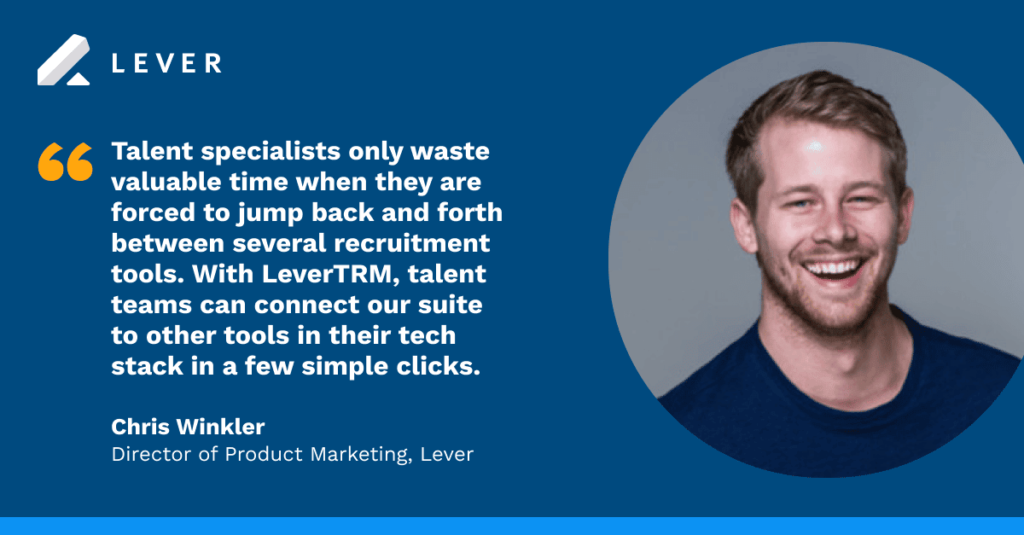
3) Communication and collaboration
From the moment a requisition is approved by your C-suite, it falls on your talent team to begin the recruitment process in earnest. That means you must find, reach out to, and set up interviews with potentially dozens of candidates for these newly active roles to eventually hire the right person.
But this process isn’t carried out entirely by your TA team.
You need to work in lockstep with other hiring team members — notably hiring managers and interview panelists — to keep the recruiting cycle moving full steam ahead and prevent candidates from exiting the funnel because of poor internal communication and collaboration.
“Hiring managers are the ones who must decide who to extend offers to,” said Chris. “But they won’t make the most informed decision about these offer extensions without getting frequent updates and data-related insights from talent specialists assigned to fill their roles.”
These updates must come in external tools for TA teams with a standalone ATS.
Talent organizations with LeverTRM can use the built-in comms functionality to notify and “nudge” hiring stakeholders to take the next logical action (e.g., provide candidate feedback and alert them to upcoming interviews).
Lever customers can also use direct connections with collaboration tools like Slack and Microsoft Teams to share news and next steps regarding active opps (e.g., via a dedicated Slack channel that sends notifications to all hiring team members about candidates’ funnel stage movement).
4) Recommendations and rediscovery
Prioritizing which candidates to engage first for an open role is often difficult for recruiters. If they’ve done their jobs well, they’ve added numerous qualified prospects to their talent pool, meaning they have multiple strong options.
That’s where LeverTRM has the edge over outmoded ATS. LeverTRM provides nurture recommendations: candidate suggestions based on hiring managers’ desired qualifications and traits.
Our solution’s proprietary algorithm generates a list of high-value prospects who, based on their profile, could be optimal fits for the positions in question.
“Artificial intelligence will never replace talent acquisition specialists,” said Roy. “That said, AI can resurface top-tier candidates for recruiters and reduce the person-hours they would otherwise have to spend assessing which candidate to contact first and foremost for a given role.”
Our ATS + CRM solution doesn’t just recommend external candidates to potentially engage. Profiles can also be created for internal candidates (i.e., existing employees at your company) to support your internal mobility program.
5) Intuitive, robust talent acquisition analytics
Your talent acquisition team doesn’t just need a repository where you can store all historical candidate and hiring-related data.
You need an actionable analytics solution that enables you to make data-driven, intelligent modifications to your daily activities and long-term planning.
A traditional ATS simply doesn’t have the analytics capabilities or data visualizations TA teams need to evaluate prospects, discover strengths and weaknesses with their pipeline management, and implement data-backed alterations to specific recruiting tactics and their strategies at large.
Visual Insights, on the other hand, checks all of these boxes.
The out-of-the-box talent analytics baked right into LeverTRM offers a dozen-plus dashboards and 30-plus data visualizations that paint a complete picture of the whole TA team and individual recruiters’ efforts.
“Custom time-to-fill and -hire calculations, dedicated dashboards for each talent and hiring team member, the ability to schedule and send custom reports to business leaders: Visual Insights has everything today’s talent teams need to build highly effective data-driven strategies,” said Chris.
“Legacy ATS impedes talent teams’ ability to improve their sourcing, nurturing and interviewing and puts them behind the curve in terms of their ability to compete for top talent with more strategic-minded TA orgs,” Chris added.
The ideal talent acquisition strategy framework
No two talent acquisition strategies are the same. However, the commonly implemented tactics and techniques from leading TA teams are common for a reason:
They lead to quick and efficient recruitment cycles, greater recruiter productivity, and more accepted offers.
Here are three businesses — small, mid-market, and enterprise companies — that established ROI-improving talent acquisition strategies with LeverTRM.
Small business with a modest TA function
TextNow’s focus on recruiting speed and efficiency pays off
- TextNow did not have enough in-house recruiting bandwidth to source the quantity and quality of candidates it needed to build a robust prospect pool. The company outsourced much of its sourcing to an RPO.
- However, lead volume still lacked, and the business lost out on qualified candidates to other employers because its recruiters couldn’t nurture the talent added to its candidate pool by the RPO in a timely manner.
- So, TextNow brought sourcing in-house and began to leverage LinkedIn for sourcing and LeverTRM to nurture applicants and sourced candidates — changes that helped the company decrease time to fill by 65%.
- TextNow also streamlined hiring manager collaboration, interview scheduling, candidate searches, and pipeline evaluation (including which stages candidates tend to “exit” the funnel most often) using LeverTRM.
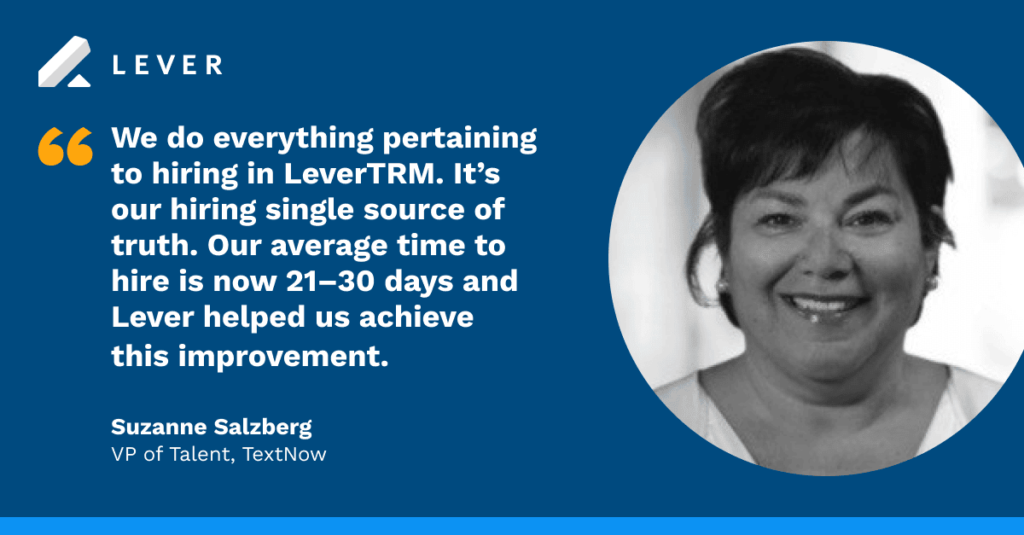
Mid-sized company with a scaling TA team
Samba.tv eliminates recruiting bottlenecks to fill roles faster
- As often happens with rapidly scaling orgs, Samba.tv outgrew its legacy ATS and needed a more advanced, user-friendly solution to help its recruiters source, nurture and interview smarter and faster.
- Samba.tv also needed a platform that connected directly with the third-party tools its recruiters used to augment candidate outreach and internal collaboration and gain more intricate pipeline insights.
- Investing in LeverTRM for Enterprise helped Samba.tv’s talent team identify, nurture, advance and monitor candidates with greater ease and “keep the [recruiting] engine running smoothly.”
- The average time to fill for Samba.tv before investing in LeverTRM was 129 days. After onboarding our TA suite, that figure sped up by 69%, leading to greater hiring manager satisfaction.
Enterprise org with many in-house recruiters
Coupa builds predictable and scalable talent acquisition engine
- Coupa Software needed to support its rapid business growth in 2022 and beyond with an accelerated hiring plan that increased its headcount by 40% (or roughly 1,300 employees) in a matter of months.
- Providing a high-quality candidate experience, achieving diversity hiring targets and further streamlining recruiting workflows remained imperative during this hyper-speed hiring period for Coupa.
- To continue to make headway with its DEI goals, ensure candidates enjoyed their recruiting experience and empower recruiters to work efficiently, Coupa needed data-driven TA tech to support this rapid growth period.
- LeverTRM helps Coupa to increase its hiring speed, hit its high-volume hiring quotas, improve recruiters’ productivity, analyze and take action on specific facets of its DEI and candidate experience efforts.
Take the tour of LeverTRM to learn how our talent acquisition suite can help you scale and grow your business as desired in 2023 and the years ahead.





